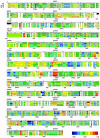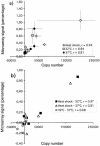Transcription profiles of the bacterium Mycoplasma pneumoniae grown at different temperatures
- PMID: 14576319
- PMCID: PMC275481
- DOI: 10.1093/nar/gkg841
Transcription profiles of the bacterium Mycoplasma pneumoniae grown at different temperatures
Abstract
Applying microarray technology, we have investigated the transcriptome of the small bacterium Mycoplasma pneumoniae grown at three different temperature conditions: 32, 37 and 32 degrees C followed by a heat shock for 15 min at 43 degrees C, before isolating the RNA. From 688 proposed open-reading frames, 676 were investigated and 564 were found to be expressed (P < 0.001; 606 with P < 0.01) and at least 33 (P < 0.001; 77 at P < 0.01) regulated. By quantitative real-time PCR of selected mRNA species, the expression data could be linked to absolute molecule numbers. We found M.pneumoniae to be regulated at the transcriptional level. Forty-seven genes were found to be significantly up-regulated after heat shock (P < 0.01). Among those were the conserved heat shock genes like dnaK, lonA and clpB, but also several genes coding for ribosomal proteins and 10 genes of unassigned functions. In addition, 30 genes were found to be down-regulated under the applied heat shock conditions. Further more, we have compared different methods of cDNA synthesis (random hexamer versus gene-specific primers, different RNA concentrations) and various normalization strategies of the raw microarray data.
Figures






Similar articles
-
Transcriptional heat shock response in the smallest known self-replicating cell, Mycoplasma genitalium.J Bacteriol. 2006 Apr;188(8):2845-55. doi: 10.1128/JB.188.8.2845-2855.2006. J Bacteriol. 2006. PMID: 16585746 Free PMC article.
-
Transcriptional analysis of the hmw gene cluster of Mycoplasma pneumoniae.J Bacteriol. 1999 Aug;181(16):4978-85. doi: 10.1128/JB.181.16.4978-4985.1999. J Bacteriol. 1999. PMID: 10438770 Free PMC article.
-
The heat-shock response of Listeria monocytogenes comprises genes involved in heat shock, cell division, cell wall synthesis, and the SOS response.Microbiology (Reading). 2007 Oct;153(Pt 10):3593-3607. doi: 10.1099/mic.0.2007/006361-0. Microbiology (Reading). 2007. PMID: 17906156
-
Re-annotating the Mycoplasma pneumoniae genome sequence: adding value, function and reading frames.Nucleic Acids Res. 2000 Sep 1;28(17):3278-88. doi: 10.1093/nar/28.17.3278. Nucleic Acids Res. 2000. PMID: 10954595 Free PMC article.
-
Expression of heat shock genes in Clostridium acetobutylicum.FEMS Microbiol Rev. 1995 Oct;17(3):341-8. doi: 10.1111/j.1574-6976.1995.tb00217.x. FEMS Microbiol Rev. 1995. PMID: 7576772 Review.
Cited by
-
Global gene expression analysis of the heat shock response in the phytopathogen Xylella fastidiosa.J Bacteriol. 2006 Aug;188(16):5821-30. doi: 10.1128/JB.00182-06. J Bacteriol. 2006. PMID: 16885450 Free PMC article.
-
Transcriptional analysis of the conserved ftsZ gene cluster in Mycoplasma genitalium and Mycoplasma pneumoniae.J Bacteriol. 2005 Jul;187(13):4542-51. doi: 10.1128/JB.187.13.4542-4551.2005. J Bacteriol. 2005. PMID: 15968065 Free PMC article.
-
Differential expression of lipoprotein genes in Mycoplasma pneumoniae after contact with human lung epithelial cells, and under oxidative and acidic stress.BMC Microbiol. 2008 Jul 23;8:124. doi: 10.1186/1471-2180-8-124. BMC Microbiol. 2008. PMID: 18647421 Free PMC article.
-
Comparative proteomic analysis of pathogenic and non-pathogenic strains from the swine pathogen Mycoplasma hyopneumoniae.Proteome Sci. 2009 Dec 21;7:45. doi: 10.1186/1477-5956-7-45. Proteome Sci. 2009. PMID: 20025764 Free PMC article.
-
Lipoprotein multigene families in Mycoplasma pneumoniae.J Bacteriol. 2006 Aug;188(15):5393-9. doi: 10.1128/JB.01819-05. J Bacteriol. 2006. PMID: 16855228 Free PMC article.
References
-
- Hecker M., Schumann,W. and Volker,U. (1996) Heat-shock and general stress response in Bacillus subtilis. Mol. Microbiol., 19, 417–428. - PubMed
-
- Velculescu V.E., Zhang,L., Vogelstein,B. and Kinzler,K.W. (1995) Serial analysis of gene expression. Science, 270, 484–487. - PubMed
-
- Williams K.L. and Hochstrasser,D.F. (1997) Introduction to the Proteome. In Wilkins,M., Williams,K., Appel,R. and Hochstrrasser,D. (eds), Proteome Research: New Frontiers in Functional Genomics. Springer Verlag, Heidelberg, Germany, pp. 1–11.
-
- Chee M., Yang,R., Hubbell,E., Berno,A., Huang,X.C., Stern,D., Winkler,J., Lockhart,D.J., Morris,M.S. and Fodor,S.P. (1996) Accessing genetic information with high-density DNA arrays. Science, 274, 610–614. - PubMed
Publication types
MeSH terms
Substances
LinkOut - more resources
Full Text Sources
Other Literature Sources

